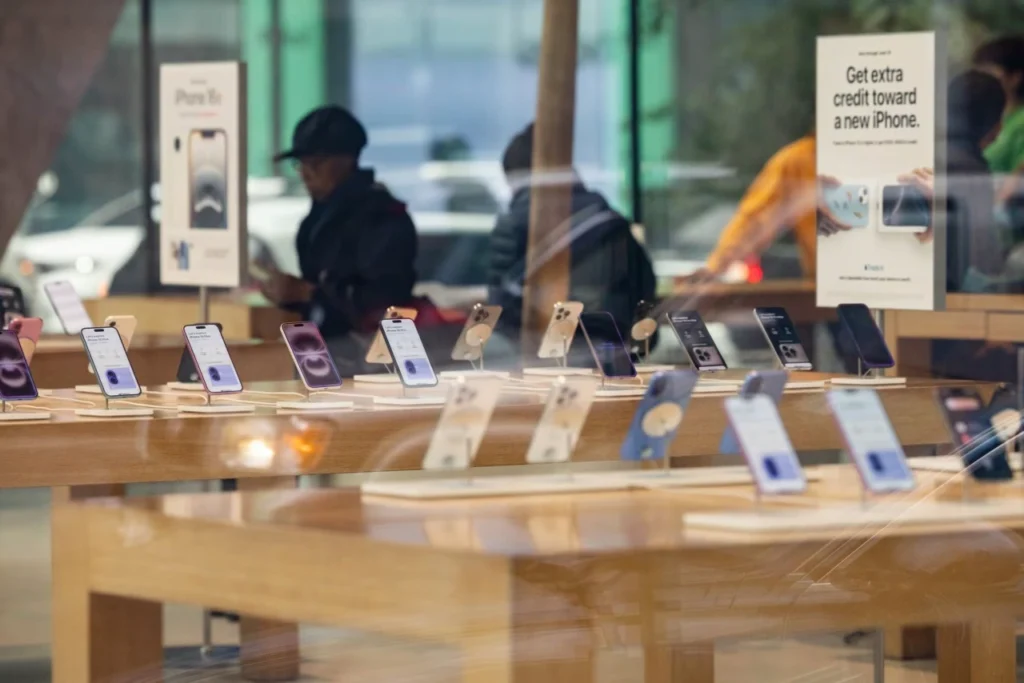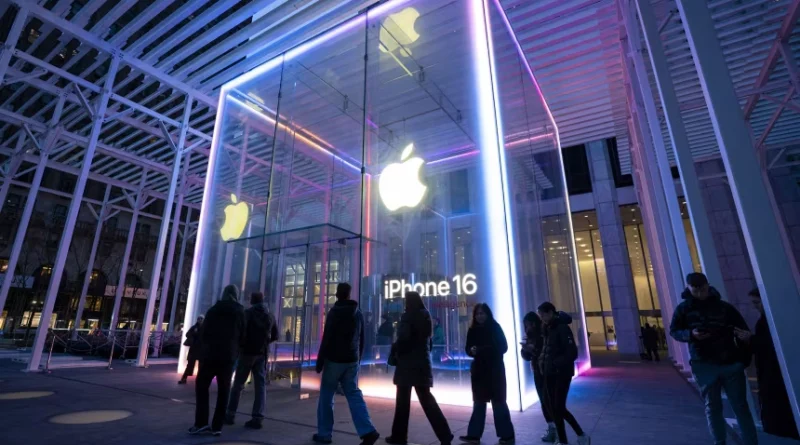Apple Gets iPhone and China Revenue Boost But Faces $1.1 Billion Tariff Hit: What’s Next?
Apple’s latest quarterly earnings report delivered some much-needed good news for the tech giant, particularly in its iPhone and China business segments. With investors’ growing concern about Apple’s lag in artificial intelligence, this improvement is timely. However, despite encouraging revenue growth, the looming pressure of trade tariffs and the company’s slow pace in AI innovation continue to cast long-term question marks over Apple’s ability to remain competitive in a rapidly evolving tech world.

iPhone Sales Rebound: A Record June Quarter
Apple reported $44.5 billion in revenue from the iPhone for the quarter ending June 2025, which not only surpasses analysts’ estimates of $40 billion but also surpasses last year’s performance of $39.3 billion. According to CEO Tim Cook, the company set a record for iPhone sales in the June quarter, representing a 13% increase year-over-year. This growth shows that even in a saturated market, Apple maintains unwavering consumer trust. The impressive results demonstrate that the iPhone is not only a luxury but also a necessity for millions of people, especially with the expansion of payments and health features in the new models.
This performance shows that the iPhone remains Apple’s crown jewel and its most important product in the eyes of investors. However, in today’s rapidly changing tech landscape, iPhone sales alone may not be enough to drive long-term growth and investor confidence. As AI becomes more embedded in devices, customers will begin to expect smarter, more friendly experiences – which Apple must provide.
China Comeback: Modest but Important Growth
China, a region where Apple has struggled recently, has also shown signs of improvement. Revenue from China grew from $14.7 billion to $15.3 billion compared to the same period last year. While this growth may seem small, it signals renewed confidence in the Apple brand in one of the world’s most competitive smartphone markets. Factors such as new retail expansions, local pricing strategies, and improved supply chain logistics may have contributed to this positive change.
While this growth is modest, it is an encouraging sign that Apple is regaining its position in an important and competitive market. With competition intensifying by Chinese tech giants such as Huawei and Xiaomi, any gains in the region will help Apple strengthen its hold and diversify its revenue sources amid global economic uncertainties.
Tariff Trouble: Apple Braces for a $1.1 Billion Hit
Despite strong sales, Apple is bracing for huge financial losses due to tariffs. CEO Tim Cook has warned that the company expects to lose $1.1 billion in tariff-related costs in the upcoming September quarter – up from the $800 million loss it reported in the previous quarter. These rising costs could force Apple to reconsider pricing products in its biggest markets, especially if trade disruptions worsen.
The tariffs are tied to ongoing changes in President Donald Trump’s trade policy that have already led Apple to shift most of its iPhone production from China to India for devices sold in the US. The strategic move has provided Apple with temporary relief, but the policy changes could complicate its global supply chain.
A tentative trade deal between the US and China capped tariffs at 30% until August 12, but rising tensions – including Trump’s recent threat to impose tariffs on India – point to continued volatility ahead. If Apple is forced to bring more manufacturing back to the US, this could have a significant impact on timelines, costs, and product availability, especially during high-demand seasons.
AI Setbacks: Apple Struggles to Keep Up
While rivals like Microsoft, Meta, and Google have raced ahead in the AI race, Apple has lagged behind. Its shares are projected to drop by about 15% in 2025, far less than tech competitors. Analysts say Apple’s delay in launching impressive AI tools is hurting its competitiveness, especially as generative AI has become central to the way users interact with technology.
Apple recently delayed a major upgrade to Siri that would have helped it catch up with advanced AI agents like OpenAI’s ChatGPT and Google’s Gemini. While Tim Cook says Apple is making “good progress” and plans to release an updated Siri next year, the company’s current AI offerings—such as custom emoji creation, text summarization, and image generation—seem modest compared to competitors. Users are increasingly expecting more dynamic, voice-first and context-aware digital assistants—areas where Apple has yet to break through.
Cook emphasized that Apple is significantly increasing its AI investments and also revealed that the company has acquired seven companies this year, some of which are AI-related. However, the loss of key AI researchers to competitors such as Meta raises concerns over Apple’s ability to play a leading role in this important field. The lack of AI affects not only products, but also Apple’s long-standing reputation as a leader in technological innovation.
“Apple has always been about taking the most advanced technologies and making them easy to use and accessible for everyone,” Cook said. “That’s at the heart of our AI strategy with Apple Intelligence.”
Is the iPhone Still Relevant in the AI Era?
AI technologies are changing the way users interact with devices—from screen-tapping to voice commands—with analysts questioning whether the iPhone will remain relevant. Tim Cook strongly defended the iPhone’s future role, saying:
“It’s difficult to see a world where iPhone’s not living in it.”
Cook believes that AI-powered devices will complement the iPhone, rather than replace it — a bet Apple is willing to stake its future on. Apple is looking at how AI can improve the experience on the device, rather than replace the iPhone entirely. Features like AI-powered personalization, battery optimization, and contextual automation could become central to iPhone evolution in the next 3-5 years.
Leadership Under Scrutiny: Calls for a Visionary CEO
Some analysts are questioning whether Tim Cook is still the right person to lead Apple through this new AI-driven era. While Cook is praised for his operational expertise and supply chain management, critics argue that Apple now needs a more visionary, product-focused leader to stay ahead. The comparison with Elon Musk, Sundar Pichai, and Satya Nadella often arises in conversations about the kind of innovation-driven leadership tech giants need today.
“He’s a supply chain guy. They need a tech visionary,” said Ted Mortonson of Baird. “I think they’re in a lot more trouble than some people think.”
Apple’s future may depend on bold product moves, not just operational efficiency. As tech evolves rapidly, the company might need fresh strategic thinking and deeper AI alignment to ensure its continued dominance.
Apple’s Strengths Tested Amid Challenges
Apple’s solid performance in iPhone sales and modest gains in China show the company is far from faltering. But with $1.1 billion in tariff costs looming, AI competition heating up, and investor confidence shaky, Apple must prove that it can adapt and lead — not just catch up. While the brand remains strong and the ecosystem loyal, growth in the next decade will depend on innovation beyond the iPhone.
The next few quarters will be critical. Will Apple’s AI vision finally materialize? Can it keep production costs under control amid shifting global trade policies? And most importantly, will the iPhone continue to anchor Apple’s success in a future increasingly dominated by artificial intelligence? For now, Apple is holding steady, but the pressure to evolve has never been more intense.
Follow us for more news at Valleynewz.com

